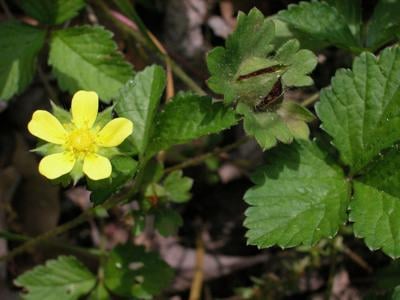
See if you can correctly identify this week’s mystery plant. [Answer: “Indian strawberry,” “Mock strawberry,” Potentilla indica]
Whatever humor this little plant might have must be truly tasteless. Well, its fruits are tasteless, anyway.
The fruits are gorgeous, brilliant red, and are dead ringers for the cultivated strawberry. Bite into it, though, and you’ll get a watery flavor, and not much else. Sort of like damp cardboard.
The true strawberries belong to a plant genus called Fragaria, and there are several species in Europe and North America. In fact, we have a couple of native wild strawberries in the eastern United States. All of the true strawberries are characterized by flowers with five sepals and five petals, many slender stamens, and a large number of tiny, separate pistils. And, they have white petals, and a fruit which is juicy, red on the inside, and very sweet. Our Mystery Plant, although not a true strawberry, has very similar flowers, but the petals are bright yellow, and its fruit is somewhat dry and mealy, white on the inside, and has practically no taste at all.
This curious plant, being closely related to the true strawberries, shares an important fruit characteristic with them. They all produce what botanists call an aggregate fruit. In this case, the interior of the flower (the receptacle) swells dramatically after pollination. Remember that it is to this receptacle that the many separate pistils are attached. Each pistil on the surface of the receptacle develops a single tiny, dark, enclosed seed, or achene, sort of like a tiny sunflower seed. Many dozens of these tiny achenes will dot the exterior of a mature strawberry. Technically then, a single flower produces several dozen tiny, dry fruits, all studding the exterior of the swollen receptacle. Those hard little black things on the outside of a strawberry are one-seeded fruits. Most people, upon getting one stuck between their teeth, will refer to it as a “seed”. But it’s a fruit. So in the case of a ripe strawberry, the part that is sweet and wonderful to eat is technically not a fruit at all. Seriously! It’s a swollen receptacle from the interior of the flower.
Our mystery species is common through all of the eastern United States, and it occurs on the Pacific Coast as well, but mostly skips the interior, between Texas and Arizona. It is not a native species, but comes from Asia, and is known from Japan through India and the Himalayas. In fact, it has become a fairly common introduction in many parts of the globe, including Europe, Africa, and the New World. Now naturalized, it is frequently seen in gardens as something of a weed. It seems to prefer moist soil, and it can endure considerable shade. Many people tolerate it in their gardens as a benign little pest, as the flowers and fruits are attractive, and birds probably eat the fruits. (Wonder if it tastes like damp cardboard to them?)
©JohnNelson2024.
John Nelson is the curator of the A. C. Moore Herbarium at the University of South Carolina, in the Department of Biological Sciences, Columbia SC 29208.
As a public service, the Herbarium offers free plant identifications. For more information, visit www.herbarium.org or call (803) 777-8196, or email nelson@sc.edu.







